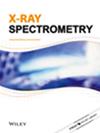IRIS:一种用于MA - XRF制图和VNIR - SWIR高光谱成像的新型集成仪器
IF 1.5
4区 物理与天体物理
Q3 SPECTROSCOPY
引用次数: 0
摘要
摘要材料分析的互补技术组合在艺术保护和学术研究中都发挥着关键作用。如今,x射线荧光(XRF)与可见光和红外区的高光谱反射成像的相关性已经成为调色板识别,绘画技术研究以及用于修复和保护的诊断支持的有价值的工具。此外,这两种技术使研究人员能够揭示迷人的底画,“笔画”,甚至是准备图纸,为艺术家的创作过程提供了新的细节。这一背景为开发一种新的多模式艺术和保护工具提供了强大的动力:IRIS。IRIS是一种可移动和可重构的扫描仪,旨在解决各种苛刻的应用,利用在400至2500 nm的可见-近红外(VNIR)和短波-红外(SWIR)范围内同时进行MA - XRF和高光谱反射扫描的机会。该系统设计用于原位,快速和非侵入性的样品扫描,而不会影响光谱分辨率和高通量性能。扫描仪获取XRF / VNIR - SWIR数据,从而允许用户从他们可能的相关信息中获得最大的利润:这两种技术可以在数据处理方面以最小的努力提供增强或互补的信息,并且不需要空间校准。在目前的工作中,IRIS的定性和定量性能进行了探讨,同时介绍了对参考样本的实验室分析和对真实案例研究的简要见解。本文章由计算机程序翻译,如有差异,请以英文原文为准。
Abstract The combination of complementary techniques for materials analysis can play a key role in both art conservation and academic research. Nowadays, the correlation of x‐ray fluorescence ( XRF ) with hyperspectral reflectance imaging in the visible and infrared region has become a valuable tool for palette identification, painting techniques studies and for the diagnostic support dedicated to restoration and conservation. Moreover, both techniques enable researchers to reveal fascinating underpaintings, “pentimenti”, or even preparatory drawings offering new details on the creative process of the artist. This background has been a strong motivation for the development of a new multimodal tool for art and conservation: IRIS . IRIS is a mobile and reconfigurable scanner designed to address a wide range of demanding application, exploiting the opportunities given by simultaneous MA‐XRF and hyperspectral reflectance scanning in the visible‐near‐infrared ( VNIR ) and short‐wave‐infrared ( SWIR ) range from 400 to 2500 nm. The system has been designed for in‐situ, fast and non‐invasive scanning of the sample without compromising spectral resolution and high throughput performance. The scanner acquires co‐registered XRF / VNIR‐SWIR data, thus allowing the user to obtain the maximum profit from their possible correlated information: the two techniques can provide enhanced or complementary information on the same spot of analysis with minimum effort in terms of data processing and no need for spatial alignment. In the present work, the qualitative and quantitative performance of IRIS are explored, together with the presentation of in‐lab analysis on reference samples and a brief insight on a real case‐study.
求助全文
通过发布文献求助,成功后即可免费获取论文全文。
去求助
来源期刊

X-Ray Spectrometry
物理-光谱学
CiteScore
3.10
自引率
8.30%
发文量
38
审稿时长
6-12 weeks
期刊介绍:
X-Ray Spectrometry is devoted to the rapid publication of papers dealing with the theory and application of x-ray spectrometry using electron, x-ray photon, proton, γ and γ-x sources.
Covering advances in techniques, methods and equipment, this established journal provides the ideal platform for the discussion of more sophisticated X-ray analytical methods.
Both wavelength and energy dispersion systems are covered together with a range of data handling methods, from the most simple to very sophisticated software programs. Papers dealing with the application of x-ray spectrometric methods for structural analysis are also featured as well as applications papers covering a wide range of areas such as environmental analysis and monitoring, art and archaelogical studies, mineralogy, forensics, geology, surface science and materials analysis, biomedical and pharmaceutical applications.
 求助内容:
求助内容: 应助结果提醒方式:
应助结果提醒方式:


